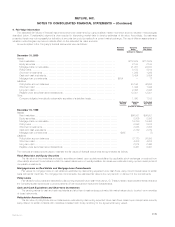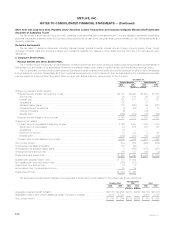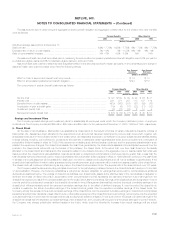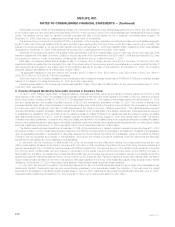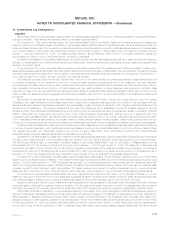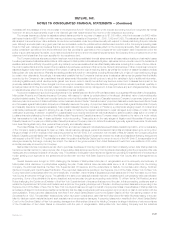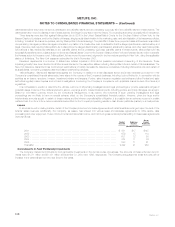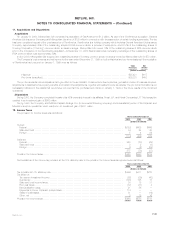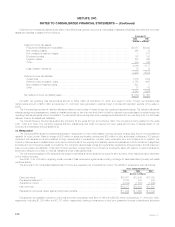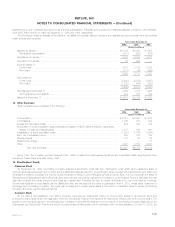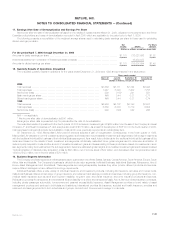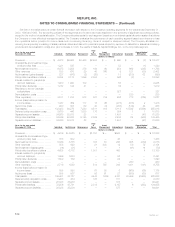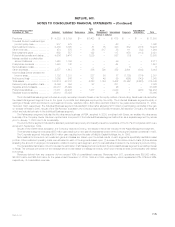MetLife 2000 Annual Report Download - page 58
Download and view the complete annual report
Please find page 58 of the 2000 MetLife annual report below. You can navigate through the pages in the report by either clicking on the pages listed below, or by using the keyword search tool below to find specific information within the annual report.METLIFE, INC.
NOTES TO CONSOLIDATED FINANCIAL STATEMENTS — (Continued)
increases with the passage of time, the increase in the experience fund in 1999 and 2000 under deposit accounting would be recognized as interest
income in an amount approximately equal to the deferred gain that was amortized into income under reinsurance accounting.
The excess insurance policies for asbestos-related claims provide for recovery of losses up to $1,500 million, which is in excess of a $400 million
self-insured retention ($878 million of which was recorded as a recoverable at December 31, 2000, 1999 and 1998). The asbestos-related policies are
also subject to annual and per-claim sublimits. Amounts are recoverable under the policies annually with respect to claims paid during the prior calendar
year. Although amounts paid in any given year that are recoverable under the policies will be reflected as a reduction in the Company’s operating cash
flows for that year, management believes that the payments will not have a material adverse effect on the Company’s liquidity. Each asbestos-related
policy contains an experience fund and a reference fund that provides for payments to the Company at the commutation date if experience under the
policy to such date has been favorable, or pro rata reductions from time to time in the loss reimbursements to the Company if the cumulative return on the
reference fund is less than the return specified in the experience fund.
The Company believes adequate provision has been made in its consolidated financial statements for all reasonably probable and estimable losses
for sales practices and asbestos-related claims. With respect to Metropolitan Life’s asbestos litigation, estimates can be uncertain due to the limitations of
available data and the difficulty of predicting with any certainty numerous variables that can affect liability estimates, including the number of future claims,
the cost to settle claims and the impact of any possible future adverse verdicts and their amounts. Recent bankruptcies of other companies involved in
asbestos litigation may result in an increase in the number of claims and the cost of resolving claims, as well as the number of trials and possible verdicts
Metropolitan Life may experience. Plaintiffs are seeking additional funds from defendants, including Metropolitan Life, in light of recent bankruptcy filings
by certain other defendants. Accordingly, it is reasonably possible that the Company’s total exposure to asbestos claims may be greater than the liability
recorded by the Company in its consolidated financial statements. Metropolitan Life will continue to study the variables in light of additional information,
including legislative and judicial developments, gained over time in order to identify trends that may become evident and to assess their impact on the
previously established liability; future charges to income may be necessary. While the potential future charges could be material in particular quarterly or
annual periods in which they are recorded, based on information currently known by management, it does not believe any such charges are likely to have
a material adverse effect on the Company’s consolidated financial position.
A purported class action suit involving policyholders in four states has been filed in a Rhode Island state court against a Metropolitan Life subsidiary,
Metropolitan Property and Casualty Insurance Company, with respect to claims by policyholders for the alleged diminished value of automobiles after
accident-related repairs. The trial court recently denied a motion by Metropolitan Property and Casualty Insurance Company for summary judgment, and
discovery has commenced. A class certification motion has been denied. Similar ‘‘diminished value’’ purported class action suits have been filed in Texas
and Tennessee against Metropolitan Property and Casualty Insurance Company. A purported class action has been filed against Metropolitan Property
and Casualty Insurance Company’s subsidiary, Metropolitan Casualty Insurance Company, in Florida by a policyholder alleging breach of contract and
unfair trade practices with respect to allowing the use of parts not made by the original manufacturer to repair damaged automobiles. A motion for class
certification is pending. In addition, a plaintiff in Louisiana state court recently amended an individual lawsuit to state a putative class action on behalf of
Louisiana insureds challenging the method that Metropolitan Property and Casualty Insurance Company uses to determine the value of a motor vehicle
that has sustained a total loss. A class certification motion is pending. These suits are in the early stages of litigation and Metropolitan Property and
Casualty Insurance Company and Metropolitan Casualty Insurance Company intend to defend themselves vigorously against these suits. Similar suits
have been filed against many other personal lines property and casualty insurers.
The United States, the Commonwealth of Puerto Rico and various hotels and individuals have sued MetLife Capital Corporation, a former subsidiary
of the Company, seeking damages for clean up costs, natural resource damages, personal injuries and lost profits and taxes based upon, among other
things, a release of oil from a barge which was being towed by the M/V Emily S. In connection with the sale of MetLife Capital, the Company acquired
MetLife Capital’s potential liability with respect to the M/V Emily S lawsuits. MetLife Capital had entered into a sale and leaseback financing arrangement
with respect to the M/V Emily S. The plaintiffs have taken the position that MetLife Capital, as the owner of record of the M/V Emily S, is responsible for all
damages caused by the barge, including the oil spill. The claims of the governments of the United States and Puerto Rico were settled in 2000 within
amounts previously accrued by the Company.
Metropolitan Life has completed a tender offer to purchase the shares of Conning Corporation that it had not already owned. After Metropolitan Life
had announced its intention to make a tender offer, three putative class actions were filed by Conning shareholders alleging that the prospective offer was
inadequate and constituted a breach of fiduciary duty. The parties to the litigation have reached an agreement providing for a settlement of the actions; a
motion seeking court approval for the settlement will be filed with the New York State Supreme Court in New York County after a final agreement is
signed.
Several lawsuits were brought in 2000 challenging the fairness of Metropolitan Life’s plan of reorganization and the adequacy and accuracy of
Metropolitan Life’s disclosure to policyholders regarding the plan. These actions name as defendants some or all of Metropolitan Life, the Holding
Company, the individual directors, the New York Superintendent of Insurance and the underwriters for MetLife, Inc.’s initial public offering, Goldman
Sachs & Company and Credit Suisse First Boston. Five purported class actions pending in the Supreme Court of the State of New York for New York
County have been consolidated within the commercial part. In addition, there remains a separate purported class action in New York state court in New
York County and another in Kings County. The plaintiffs in the state court class actions seek injunctive, declaratory and compensatory relief, as well as an
accounting. Some of the plaintiffs in the above described actions have also brought a proceeding under Article 78 of New York’s Civil Practice Law and
Rules challenging the Opinion and Decision of the New York Superintendent of Insurance that approved the plan. In this proceeding, petitioners seek to
vacate the Superintendent’s Opinion and Decision and enjoin him from granting final approval of the plan. Another purported class action is pending in the
Supreme Court of the State of New York for New York County and has been brought on behalf of a purported class of beneficiaries of Metropolitan Life
annuities purchased to fund structured settlements claiming that the class members should have received common stock or cash in connection with the
demutualization. Three purported class actions were filed in the United States District Court for the Eastern District of New York claiming violation of the
Securities Act of 1933. The plaintiffs in these actions, which have been consolidated, claim that the Policyholder Information Booklets relating to the plan
failed to disclose certain material facts and seek rescission and compensatory damages. A purported class action was filed in the United States District
Court for the Southern District of New York seeking damages from Metropolitan Life and the Holding Company for alleged violations of various provisions
of the Constitution of the United States in connection with the plan of reorganization. Metropolitan Life, the Holding Company and the individual
MetLife, Inc. F-27




